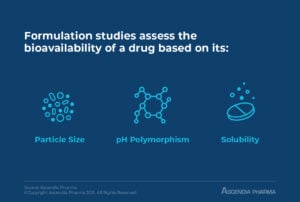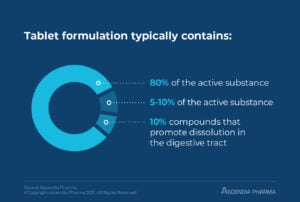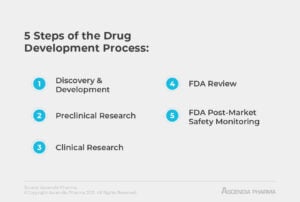Formulation Development: Why It’s So Important
Drug formulation is one of the most critical aspects of the pharmaceutical development process. If a drug cannot be delivered in a stable form that is acceptable to the patient, it is unlikely to find a sizable market, and it may not even go beyond Phase I clinical trials. At Ascendia Pharma, we provide drug formulation development for both clinical trials and final dosages. Below, we share our insight into the drug formulation process.
What Is Drug Formulation?

When a new drug is developed, it is not developed in its final form. Instead, an active ingredient, or molecule, is identified through scientific research. Drug formulation is the process of determining the best way to deliver this active ingredient.
Also known as pharmaceutical formulation, drug formulation involves combining different inactive substances with the active pharmaceutical ingredient (API) to produce an end-product for patients. In addition to selecting inactive substances to add to the active ingredient, drug formulation involves choosing the best form for a drug, whether it’s an oral suspension, tablet, or injection.
Drug formulation doesn’t just occur once in the drug development process. There are formulations for clinical trials, formulations for different dosages, and formulations for different delivery methods if more than one is desired.
The Pharmaceutical Formulation Development Process
Drug preformulation studies are the first step in formulation development. During this phase, we identify the chemical, physical, and mechanical properties of a drug to determine the inactive ingredients, or excipients, that should be paired with it. The goal is to create a formulation that is stable under a variety of conditions, from extreme cold to extreme heat. Adding excipients can change a drug’s qualities and ensure an end-product that doesn’t degrade during shipment or storage.

Formulation studies assess the bioavailability of a drug based on its particle size, pH, polymorphism, and solubility; inactive ingredients must be added in such a way that the formulation of each dosage is consistent so there is no variation from one tablet or capsule to the next. Dosages must also have a standardized appearance and a tolerable taste, and oral medications must be fully broken down in the digestive tract.
Another factor that is considered in formulation studies is the container a drug will be stored in, whether it’s a blister pack, vial, bottle, syringe, or ampoule; plastic or glass. It’s possible that there may be interactions between the preparation of a drug and the container it’s housed in. If tablets are stored in a plastic container, will they absorb chemicals leached from the plastic? Or will the plastic absorb active ingredients from the tablets? These questions are answered during formulation studies.
Drug Formulation Types
There are many types of formulations available for drugs. Chemical properties of both the active and inactive ingredients may be used to determine the best route of administration for a drug, but there are a number of other factors at play, including how quickly a drug should be absorbed or what we expect it to do in the body. Formulation types include:

Tablet Formulation
These typically contain five to 10 percent of the active substance, 80 percent inactive ingredients, and 10 percent compounds that promote dissolution in the digestive tract.
Capsule Formulation
Capsules involve encasing the active substance in a “shell” made with a gelling agent that dissolves in the stomach.
Oral Liquid Formulation
Liquid formulations are faster and less expensive to develop, and they often have better bioavailability than other oral formulations.
Sustained Release Formulation
Sustained release formulations can be tablets or capsules. They are meant to release a drug into the system more slowly.
Parenteral Formulation
These formulations may be liquid or lyophilized (freeze-dried), and they are either injected or applied directly to the mucus membranes (I.e., nose drops).
Cutaneous Formulation
Cutaneous formulations are creams, ointments, gels, powders, and pastes that are applied topically to the skin.
With some classes of drugs, the formulation type doesn’t require much trial-and-error on the part of researchers. For example, a dermatological drug for rosacea or acne is likely to have a cutaneous application; most biologics are parenteral drugs that are administered via injection. In other circumstances, there may be a number of different options available, requiring careful thought and research into the best formulation type from the perspectives of patients, manufacturing, and stability.
Drug Formulation Development for Clinical Trials
Some people may be surprised to learn that formulation studies are often ongoing during early clinical trials. This is because time is of the essence when a pharmaceutical company wants to be the first on the market with a new class of drug; in addition, only a small number of drugs ever make it to market, so pharmaceutical companies are hesitant to start formulation studies too early in the process. Once efficacy and safety are established, clinical trials commence, even while formulations are still being studied.

Phase I clinical trials use simple drug formulations that are designed specifically for trials and not meant to go to market. Usually, capsules are hand-filled with the active pharmaceutical ingredient, along with a diluent. These formulations may not be stable in the long term, but they don’t have to be, as they’re typically used within days.
During phase III clinical trials, formulation studies are usually either complete or a preparation is available that is close to what will be used when the drug is ready to market. This is the point where a drug must be stable, and drug companies must be aware of the conditions in which it must be stored. Stability studies evaluate whether temperature, oxidation, humidity, or light exposure affect the drug or cause degradation and a decrease in efficacy.
Drug Formulation Challenges During Early Phase Development
The pharmaceutical industry faces a number of challenges in early phase drug development. Some of the most common include:
Solubility
Many compounds are poorly soluble and have low oral bioavailability, which complicates drug formulation. When absorption rates vary from one person to the next, pharmacokinetics are compromised. Formulation studies are used to identify the best method of improving solubility.
Stability
A new drug should be stable throughout its shelf life, without degrading or converting from one form to another (polymorphism).
Dose Range
Determining the appropriate dose range, as well as the appropriate formulation for different doses, is another challenge during early phase development. Modeling software can be used as a starting point for pinpointing an appropriate dose for human consumption.
API Availability
In the early stages of drug development, API is often in high demand and short supply for formulation studies.
Not all drugs face all of these challenges, but it’s fair to say that most have at least one challenge that they must overcome. Partnering with a manufacturer who has experience overcoming these hurdles through innovation and state-of-the-art technology is critical.
Why Is Drug Formulation Development Important?
Aside from the initial discovery of a new drug, drug formulation is perhaps the most important part of the development process. It can make or break a drug; if a molecule cannot be made stable, it cannot go to market.

During the drug formulation process, researchers look for solutions that are scalable for manufacturing. As with stability, this is a critical factor in the success of a drug. Drugs with complex formulations may be difficult to scale, as specialized manufacturing facilities may be needed. This can impact the pricing and availability of a drug.
Why Outsource Drug Formulation Development to Ascendia
At Ascendia, we understand the pressures of the drug development process. Speed is important, but so is innovation and problem-solving. We’re able to meet rapid development timelines and we offer services to help you reach early-stage milestones quickly. By saving you time at every step of the process, we’ll help ensure that your drug is on the market as fast as possible.
Ascendia’s drug formulation services include:
- – Preformulation studies
- – Formulations for toxicology studies
- – Formulations for pharmacokinetic studies
- – Pilot ANDA formulations
- – Phase I clinical trial materials for parenteral and oral products.
Once a drug has successfully moved through the first phases of clinical trials, Ascendia can select and develop a final dosage form based on your commercial and manufacturing needs, as well as the properties of the drug. We can provide you with a range of final dosage form options:
Oral Dosage Formulations
We can formulate both immediate release and modified release tablets through granulation, blending, and roller compaction. Small capsule batches for controlled release products can be made with fluid-bed coated particles. For pediatric formulations, we offer suspensions and orally disintegrating tablets that are taste-masked.
Parenteral Formulations
Ascendia has the ability to manufacture nanoparticles using ball milling techniques to produce nano-emulsions for parenteral drug formulations. Such formulations can be administered as permanent suspensions for injection, or they can be lyophilized for physical stability.
Topical Formulations
Ascendia has the ability to formulate creams and ointments for topical application to the skin or mucous membranes, as well as nano-emulsions that are suitable for ophthalmic drop application to the eyes. We also manufacture suspensions for use in nasal sprays.
Learn More About Drug Formulation Development
Contact us today to discuss your formulation development needs.

